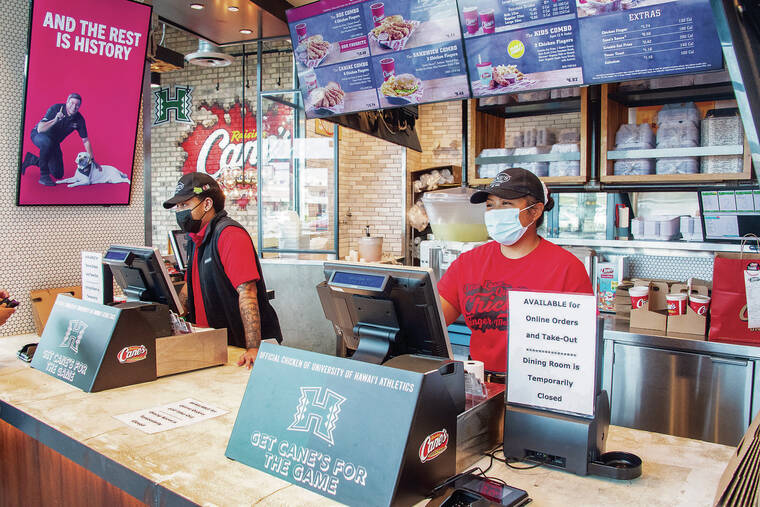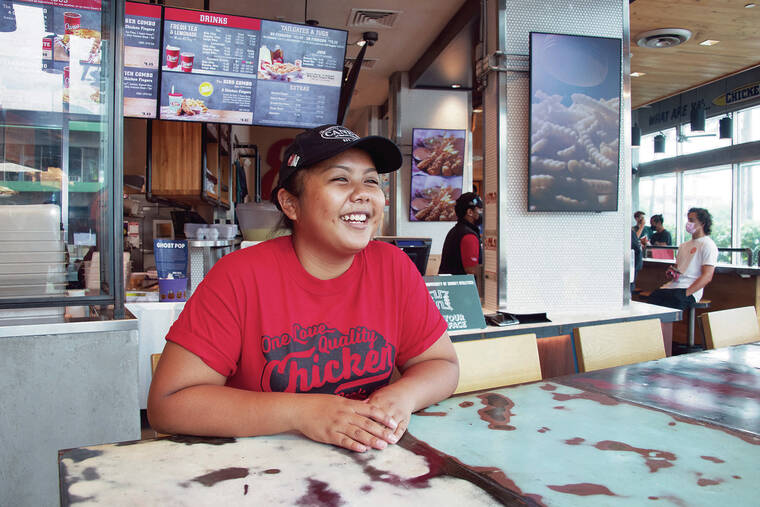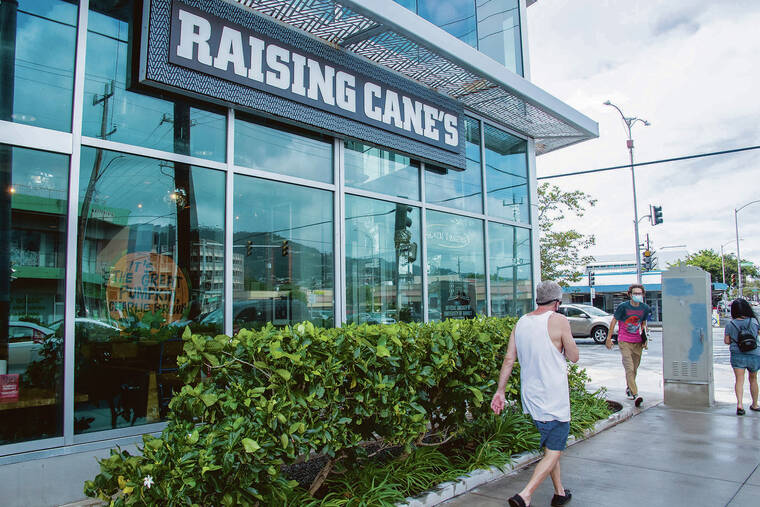It’s a sign of the times that Katelyn Prak, a 17-year-old without prior work experience, is making $14 an hour as an entry-level hire at Raising Cane’s Chicken Fingers.
Prak, a McKinley High School senior and cheerleader, hopes to use the job to help save money to fund a teaching degree. She’s poised and hardworking, but the fact that she is so coveted by employers that it took her only four months to find an over-minimum-wage job is a phenomenon of the current job market.
“There were a lot of jobs available,” said Prak, who started at Raising Cane’s in July. “Raising Cane’s had the best wages, but I also took into consideration flexibility, location and work environment. I feel very supported by Raising Cane’s. We are planning a fundraiser at Raising Cane’s for the McKinley High cheerleaders in October to help pay for cheerleading expenses like uniforms and pompoms.”
Before the pandemic, Hawaii had labor shortages because it had the lowest unemployment rate in the country. During the pandemic, Hawaii’s unemployment soared to the highest in the country, and while it has improved some, thousands of people are still unemployed. Compounding the situation is that those who are unemployed might not have the skills to fill open jobs. The competitive environment, the pandemic and vaccine mandates also have made it hard for employers to hold onto their current workforce.
Hawaii employers who are desperate to fill jobs have posted a record-high number of job openings. Chamber of Commerce Hawaii President and CEO Sherry Menor-McNamara said there are more than 32,000 jobs available on Hawaiiishiring.com, a hiring and workforce development site created during the pandemic by the chamber and other community collaborators.
Menor-McNamara said that in July over 80% of employers surveyed by the chamber said they were experiencing labor shortages, and by September that number had improved to only 53%. Employers said about 21% of the shortage was due to the vaccine mandates, with other factors like mismatched skill sets or job satisfaction issues weighing in more heavily.
She said employers are raising pay, offering bonuses and are getting creative with fringe benefits that can range from paid parking to educational and training benefits to flexible hours to remote work or other hybrid-working arrangements.
Still, incentives alone haven’t gotten enough workers off the bench, especially when COVID-19 restrictions mean that some employees and employers are still in limbo. If the trend continues, Menor-McNamara says, it could mar Hawaii’s chance to expand the economy to keep up with consumption.
“Anecdotally, when we talk to some businesses, they tell us that they are having to close some days because they don’t have enough workers. In addition, the current restrictions are impacting the supply chains,” she said.
In the earlier part of the pandemic, employers blamed extra federal benefits for the unemployed and the child care issues that emerged with school closures. But schools are mostly back in session, and the federal programs connected to unemployment ended Sept. 4 in Hawaii.
Paul Brewbaker, principal of TZ Economics, said it’s clear that Hawaii’s classic and omnipresent struggle with “skills mismatch” has been aggravated by the disruptive outcomes associated with the pandemic.
“Problems range from firms which no longer exist to industries which dramatically had to transform to the prevalence of remote work, in addition to the small proportions of workers who worked remotely pre-COVID,” Brewbaker said.
Prior to the pandemic, remote workers made up about 3% or 4% of the workforce. Now, he said, it’s closer to 20% to 25% of all workers and higher proportions of highly educated workers and higher proportions of women.
“Not all Hawaii workers have the technical skills or the technical equipment to work remotely,” Brewbaker said.
Also, he said the world has evolved since the pandemic, and employers have to find a way to respond to the changing psyche of the workforce. Many people who lost jobs during the pandemic have yet to start looking again. Some would- be job-seekers remain fearful of the coronavirus, especially given the recent spread of the delta variant. Some have struggled to find or afford child care at a time when the status of schools is in flux. Others are rethinking their lives and careers after being locked in at home and spending more time with their families.
“There are more people saying, ‘Take this job and shove it,’” Brewbaker said.
Lester Maximo, store manager at Kahala T&C Surf Designs, said retention has been just as difficult as recruitment this year. Still, he is optimistic that things are improving after a strong turnout at a Kahala Mall job fair earlier this month netted some new workers.
“Usually, we lose a couple of people a year. We lost eight right at the end of summer when five high schoolers left for college and three other employees left for other opportunities,” he said. “We are possibly looking at trying to be more competitive with the entry pay. We are a small store, so it’s hard to pay what the bigger chains are offering. The passion of the sport is what tends to attract applicants.”
To be sure, the U.S. Labor Department reported that quits jumped to 4.3 million in August, the highest on records dating back to December 2000 and up from 4 million in July. That’s equivalent to nearly 3% of the nation’s workforce. Hiring also slowed in August, the report showed, and the number of jobs available fell to 10.4 million from a record high of 11.1 million the previous month.
Brewbaker said there isn’t good Hawaii data on job quits, but the national data is instructive.
“When there are more job openings, the unemployment rate tends to fall as people move into those openings, and vice versa when the number of job openings is low,” he said. “Currently, the number of job openings is extraordinarily high, relative to the amount of unemployment there is.”
Job growth nationwide has been trending in the wrong direction for at least a couple of months. The U.S. Labor Department reported that nationwide, employers added just 235,000 jobs in August — only about a third of the number that economists had expected and down dramatically from around 1 million jobs that were added in June and July each.
U.S. employers added just 194,000 jobs in September, a second straight tepid gain and evidence that the pandemic has kept its grip on the economy, with many companies struggling to fill millions of open jobs.
The U.S. Labor Department reported that the nation’s unemployment rate sank last month to 4.8% from 5.2%. But the percentage is deceiving, given that the rate drop wasn’t only because people found jobs. Another reason for the drop is that 180,000 fewer people looked for work in September, which meant they weren’t counted as unemployed.
September numbers aren’t yet available for Hawaii, which was still trailing behind the rest of the U.S. in August. Hawaii’s jobless rate in August dropped to a 17-month low of 7% — its seventh consecutive monthly decline — while job growth stalled.
Emy Yamauchi-Wong, manager of ALTRES Office/Professional and ALTRES Technical, said the situation in Hawaii is difficult for employers, but perhaps not as markedly as it’s been on the mainland.
“We’ve always had a lot of companies looking to hire but not enough candidates to fill all our open jobs. That hasn’t changed, although it did get worse with the pandemic because more were on unemployment,” she said. “We were all hoping and waiting for this whole influx of people coming off of unemployment, but it really hasn’t increased the candidate pool.”
Yamauchi-Wong said that’s mainly because some workers are still waiting to see whether current employers would be able to bring them back from furloughs or give them more hours. She said furloughed job candidates have been reluctant to leave longtime employers because they risk giving up seniority or other longtime benefits.
In Hawaii, she said, most “people can’t just afford to quit. Even if they do qualify for unemployment, it’s not enough to support a family here in Hawaii, and a lot of people are working two jobs.”
Yamauchi-Wong said the current situation is a great time for applicants to find upwardly mobile jobs with employers who are more willing to invest in training and offering creative benefits that fit their needs.
She said ALTRES offers free placement services to job-seekers. ALTRES also offers paid services for employers ranging from making sure that their listings are competitive to recruiting and screening qualified applicants.
Yamauchi-Wong said one of the major differences in this job market is that when employers find the right candidate, they have to move even faster than they did before.
“The biggest difference is that the candidates are having multiple offers,” she said. “Once you have a candidate that you are interviewing and you are considering, we really stress that you should be making a decision within a week.”
Ali Urbick, marketing leader for Raising Cane’s and Panda Express stores in Hawaii, Alaska and Guam, who also works on special mainland projects, said Hawaii employers have it rough but perhaps not as bad as employers in some mainland states.
“In other areas it’s significantly worse for us as a company,” Urbick said. “Industrywide, the South is having a particularly hard time.”
Raising Cane’s is in a Hawaii expansion mode and has to hire at least 100 more workers in December. That’s a serious challenge in Hawaii, where many companies are struggling to fill jobs. But Urbick said she is confident that Raising Cane’s reputation as a good employer and its community outreach will help it navigate challenges similarly to when it opened three Hawaii stores in 2020 and two new Hawaii stores earlier this year. The story is similar for Panda Express, which opened one new Hawaii store in 2020, she said.
“People have called it a labor shortage, but it’s a labor reckoning. The pandemic has reinforced the need for companies to always be recruiting, not just in the traditional sense, but in daily actions,” she said.
Star-Advertiser reporter Dave Segal and The Associated Press contributed to this story.






